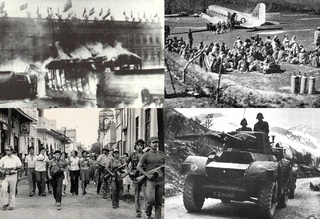Chelageyan Civil War
This article is incomplete because it is pending further input from participants, or it is a work-in-progress by one author. Please comment on this article's talk page to share your input, comments and questions. Note: To contribute to this article, you may need to seek help from the author(s) of this page. |
| Chelageyan Civil War | |||||||
|---|---|---|---|---|---|---|---|
| Part of the Great Game | |||||||
 Clockwise, from top left: Government Plaza in Digalua during the 2 January 1938 coup d'état, LNJ soldiers supplied by the Mascyllary Air Force, Ochoccolan mechanized infantry in Ahcoma (October 1952), armed civilians recruited by the MNAP in Fort d'Augustin (December 1949) | |||||||
| |||||||
| Belligerents | |||||||
|
Supported by: |
Supported by: | ||||||
| Commanders and leaders | |||||||
|
| |||||||
| Casualties and losses | |||||||
|
1937–1951
1951–1955
|
1937–1951
1951–1955
| ||||||
The Chelageyan Civil War (Sarracese: Guerre civile chélagaise), also referred to as the Chelageyan Revolution (Sarracese: Révolution chélagaise), was a period of political instability and civil war in Chelagey from 1938 to 1955. It is generally agreed to encompass three distinct phases: the insurgent opposition to the loyalist remnants of the authoritarian dictatorship of Omema Cheueta after his assassination in 1938 and the attempts by rivaling factions within the military and the National Popular Action Movement (MNAP) to oust it; the subsequent campaign of the Clement Leroy Couchér-led military government against the Ochoccola-backed Ditlihis beginning in 1951; and the near-simultaneous war fought between the Couchér regime and the PRO over the Akonshuk region on Godrica, which is sometimes regarded as the distinct Chelago–Ochoccolan War of 1952–1955 or the First Akonshuk War (Sarracese: Première guerre du Aconchúque).
Omema Cheueta ruled as de facto Chelageyan dictator from 1930 to 1937 until his assassination by then-believed affiliates of the Communist Party of Chelagey (PCC) during the 1938 New Year's Eve celebrations. In actuality, his assassination was an attempt by rogue officials in the Chelageyan military, led by Major General Clement Leroy Couchér, to seize power in a swift coup d'état, but instead, the organization and chain of command of the armed forces broke apart on the question of loyalty. The rapidly developing power vacuum, unable to be filled by Cheueta's interim government in Digalua, ultimately allowed for political turmoil to take root. Couchér proclaimed his newly-formed government to be the sole legitimate one on 2 January, while Cheueta's brother Alfonso Cheueta attempted to return control over the country to the Cheueta family through a counter-coup on 4 January. Simultaneously, the outlawed PCC was re-organized into the MNAP, an alliance of militant socialist and communist political parties and groups, and launched an insurgency against both claimant governments by May.
The ensuing armed conflict was exceptionally brutal with numerous accounts of reported war crimes such as summary execution, extrajudicial killing, the intentional targeting and killing of civilians, enforced disappearances, wartime sexual violence, torture, and the conscription of children into militias; estimates of casualties vary widely due to war-time censorship and the arbitrary nature of the crimes committed, but most estimate up to 45,000–79,000 deaths in total. In the rural areas and hinterland, strongholds of insurgent groups and military forces in villages and small towns were the target of civilian massacres which are accused of having been intentional acts of ethnic cleansing and genocide of native Shuelah. Many historians agree that the exceptional violence was a largely one-sided campaign by Couchér's military junta against the civilian peasantry population to terrorize and subjugate; however, others point to numerous occasions of similar crimes committed by Cheueta's equally brutal military forces, as well as fringe left-wing militias. Other victims of the violence were notably activists, journalists, political opponents, artists, academics, and trade unionists.
Military actions by the MNAP, the Couchér, and the Cheueta governments spilt over into the newly-established First Ochoccolan Republic by 1948 and precipitated the 1950 coup d'état and creation of the People's Republic of Ochoccola (PRO) on 15 April 1950. On 16 July 1951, Couchér assumed control over Digalua with Mascyllary military support and dissolved Cheueta's rivaling government to facilitate total control; Cheueta was imprisoned and executed on 20 July. Infighting inside the MNAP after Claude Lamar's death caused its collapse in August of 1951 and allowed the Ditlihis under Wohali Cheuttemwaqa to emerge as the most powerful splinter group and secure the material support of the PRO and other communist countries. On 30 April 1952, Ochoccolan military forces precipitated a land invasion by infiltrating southwestern Chelagey in an effort to occupy and capture Akonshuk, a historically disputed territory, and aid the Ditlihis in ousting Couchér's effective military junta at large. The front solidified gradually as the inexperienced and largely under-equipped Ochoccolan and Chelageyan armed forces came to a grinding halt by spring of 1953 in the Sequachie Mountains.
After two years of stalemate, intervention by the Assembly of Nations forced both sides to relent and concede to a ceasefire on 1 March 1955 and the establishment of the then-current military control line as the Line of Control in Akonshuk on 25 March through the Port Alfred Agreement. Coincidentally, the Couchér regime gained the upper hand in the civil war and declared to be victorious, despite attempts by the AN to negotiate a political solution to Chelageyan governance. No peace accords or agreement were signed between Chelagey and Ochoccola, or the belligerent parties of the conflict in Chelagey; Couchér ruled as self-proclaimed President until his death in 1967, stabilizing Chelageyan military rule and thus delaying a political transition to a democracy for another 33 years. The tensions and disputes unresolved by the Port Alfred Agreement came a head just X years later, with the Second Akonshuk War in X. The 1938–1955 conflict was a significant period in Chelagey's and Ochoccola's history, and was among the first proxy wars of the Great Game.
